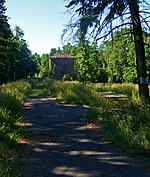Lock Tender's House and Canal Store Ruin
Delaware and Hudson CanalHouses completed in 1848Houses in Ulster County, New YorkHouses on the National Register of Historic Places in New York (state)National Register of Historic Places in Ulster County, New York ... and 3 more
Ruins on the National Register of Historic PlacesTransportation buildings and structures on the National Register of Historic Places in New York (state)Water transportation buildings and structures on the National Register of Historic Places

The Lock Tender's House and Canal Store Ruin is located on Canal Road in High Falls, New York, United States. It is a complex along the former route of the Delaware and Hudson Canal built in the middle of the 19th century. The Lock Tender's House is one of the few surviving such structures along the length of the canal in New York or Pennsylvania. The store ruins are also one of the few remnants of the canal's ancillary buildings. Both can be seen from a nearby public trail along the canal bed. In 1998 the property was listed on the National Register of Historic Places.
Excerpt from the Wikipedia article Lock Tender's House and Canal Store Ruin (License: CC BY-SA 3.0, Authors, Images).Lock Tender's House and Canal Store Ruin
Five Lock Walk,
Geographical coordinates (GPS) Address Nearby Places Show on map
Geographical coordinates (GPS)
| Latitude | Longitude |
|---|---|
| N 41.823611111111 ° | E -74.130833333333 ° |
Address
Five Lock Walk
Five Lock Walk
12440
New York, United States
Open on Google Maps








